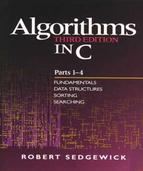Book Description
Robert Sedgewick has thoroughly rewritten and substantially expanded his popular work to provide current and comprehensive coverage of important algorithms and data structures. Many new algorithms are presented, and the explanations of each algorithm are much more detailed than in previous editions. A new text design and detailed, innovative figures, with accompanying commentary, greatly enhance the presentation. The third edition retains the successful blend of theory and practice that has made Sedgewick's work an invaluable resource for more than 250,000 programmers!
This particular book, Parts 1-4, represents the essential first half of Sedgewick's complete work. It provides extensive coverage of fundamental data structures and algorithms for sorting, searching, and related applications. The algorithms and data structures are expressed in concise implementations in C, so that you can both appreciate their fundamental properties and test them on real applications. Of course, the substance of the book applies to programming in any language.
Highlights
Expanded coverage of arrays, linked lists, strings, trees, and other basic data structures
Greater emphasis on abstract data types (ADTs) than in previous editions
Over 100 algorithms for sorting, selection, priority queue ADT implementations, and symbol table ADT (searching) implementations
New implementations of binomial queues, multiway radix sorting, Batcher's sorting networks, randomized BSTs, splay trees, skip lists, multiway tries, and much more
Increased quantitative information about the algorithms, including extensive empirical studies and basic analytic studies, giving you a basis for comparing them
Over 1000 new exercises to help you learn the properties of algorithms
Whether you are a student learning the algorithms for the first time or a professional interested in having up-to-date reference material, you will find a wealth of useful information in this book.
Table of Contents
- About This eBook
- Title Page
- Copyright Page
- Preface
- Dedication Page
- Notes on Exercises
- Contents
- Part One: Fundamentals
- Part Two: Data Structures
- Chapter Three. Elementary Data Structures
- Chapter Four. Abstract Data Types
- 4.1 Abstract Objects and Collections of Objects
- Exercises
- 4.2 Pushdown Stack ADT
- Exercises
- 4.3 Examples of Stack ADT Clients
- Exercises
- 4.4 Stack ADT Implementations
- Exercises
- 4.5 Creation of a New ADT
- Exercises
- 4.6 FIFO Queues and Generalized Queues
- Exercises
- 4.7 Duplicate and Index Items
- Exercises
- 4.8 First-Class ADTs
- Exercises
- 4.9 Application-Based ADT Example
- Exercises
- 4.10 Perspective
- Chapter Five. Recursion and Trees
- References for Part Two
- Part Three: Sorting
- Chapter Six. Elementary Sorting Methods
- 6.1 Rules of the Game
- Exercises
- 6.2 Selection Sort
- Exercises
- 6.3 Insertion Sort
- Exercises
- 6.4 Bubble Sort
- Exercises
- 6.5 Performance Characteristics of Elementary Sorts
- Exercises
- 6.6 Shellsort
- Exercises
- 6.7 Sorting of Other Types of Data
- Exercises
- 6.8 Index and Pointer Sorting
- Exercises
- 6.9 Sorting of Linked Lists
- Exercises
- 6.10 Key-Indexed Counting
- Exercises
- Chapter Seven. Quicksort
- Chapter Eight. Merging and Mergesort
- 8.1 Two-Way Merging
- Exercises
- 8.2 Abstract In-place Merge
- Exercises
- 8.3 Top-Down Mergesort
- Exercises
- 8.4 Improvements to the Basic Algorithm
- Exercises
- 8.5 Bottom-Up Mergesort
- Exercises
- 8.6 Performance Characteristics of Mergesort
- Exercises
- 8.7 Linked-List Implementations of Mergesort
- Exercises
- 8.8 Recursion Revisited
- Exercises
- Chapter Nine. Priority Queues and Heapsort
- Chapter Ten. Radix Sorting
- Chapter Eleven. Special-Purpose Sorting Methods
- References for Part Three
- Chapter Six. Elementary Sorting Methods
- Part Four: Searching
- Chapter Twelve. Symbol Tables and Binary Search Trees
- 12.1 Symbol-Table Abstract Data Type
- Exercises
- 12.2 Key-Indexed Search
- Exercises
- 12.3 Sequential Search
- Exercises
- 12.4 Binary Search
- Exercises
- 12.5 Binary Search Trees (BSTs)
- Exercises
- 12.6 Performance Characteristics of BSTs
- Exercises
- 12.7 Index Implementations with Symbol Tables
- Exercises
- 12.8 Insertion at the Root in BSTs
- Exercises
- 12.9 BST Implementations of Other ADT Functions
- Exercises
- Chapter Thirteen. Balanced Trees
- Chapter Fourteen. Hashing
- Chapter Fifteen. Radix Search
- Chapter Sixteen. External Searching
- Chapter Twelve. Symbol Tables and Binary Search Trees
- References for Part Four
- Index
- Code Snippets
